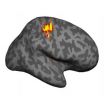(Press-News.org) March 5, 2013 (Toronto) – Some of the dramatic differences seen among patients with schizophrenia may be explained by a single gene that regulates a group of other schizophrenia risk genes. These findings appear in a new imaging-genetics study from the Centre for Addiction and Mental Health (CAMH).
The study revealed that people with schizophrenia who had a particular version of the microRNA-137 gene (or MIR137), tended to develop the illness at a younger age and had distinct brain features – both associated with poorer outcomes – compared to patients who did not have this version. This work, led by Drs. Aristotle Voineskos and James Kennedy, appears in the latest issue of Molecular Psychiatry.
Treating schizophrenia is particularly challenging as the illness can vary from patient to patient. Some individuals stay hospitalized for years, while others respond well to treatment.
"What's exciting about this study is that we could have a legitimate answer as to why some of these differences occur," explained Dr. Voineskos, a clinician-scientist in CAMH's Campbell Family Mental Health Research Institute. "In the future, we might have the capability of using this gene to tell us about prognosis and how a person might respond to treatment."
"Drs. Voineskos and Kennedy's findings are very important as they provide new insights into the genetic bases of this condition that affects thousands of Canadians and their families," said Dr. Anthony Phillips, Scientific Director at the Canadian Institutes of Health Research Institute of Neurosciences, Mental Health and Addiction.
Also, until now, sex has been the strongest predictor of the age at which schizophrenia develops in individuals. Typically, women tend to develop the illness a few years later than men, and experience a milder form of the disease.
"We showed that this gene has a bigger effect on age-at-onset than one's gender has," said Dr. Voineskos, who heads the Kimel Family Translational Imaging-Genetics Research Laboratory at CAMH. "This may be a paradigm shift for the field."
The researchers studied MIR137 — a gene involved in turning on and off other schizophrenia-related genes — in 510 individuals living with schizophrenia. The scientists found that patients with a specific version of the gene tended to develop the illness at a younger age, around 20.8 years of age, compared to 23.4 years of age among those without this version.
"Although three years of difference in age-at-onset may not seem large, those years are important in the final development of brain circuits in the young adult," said Dr. Kennedy, Director of CAMH's Neuroscience Research Department. "This can have major impact on disease outcome."
In a separate part of the study involving 213 people, the researchers used MRI and diffusion tensor-magnetic resonance brain imaging (DT-MRI). They found that individuals who had the particular gene version tended to have unique brain features. These features included a smaller hippocampus, which is a brain structure involved in memory, and larger lateral ventricles, which are fluid-filled structures associated with disease outcome. As well, these patients tended to have more impairment in white matter tracts, which are structures connecting brain regions, and serving as the information highways of the brain.
Developing tests that screen for versions of this gene could be helpful in treating patients earlier and more effectively.
"We're hoping that in the near future we can use this combination of genetics and brain imaging to predict how severe a version of illness someone might have," said Dr. Voineskos. "This would allow us to plan earlier for specific treatments and clinical service delivery and pursue more personalized treatment options right from the start."
###This research was funded by the Canadian Institutes of Health Research, the Brain & Behavior Research Foundation and the Ontario Mental Health Foundation.
Media contact: Anita Dubey; (416) 535-8501 ext. 4932; anita.dubey@camh.ca.
The Centre for Addiction and Mental Health (CAMH) is Canada's largest mental health and addiction teaching hospital, as well as one of the world's leading research centres in its field.
CAMH combines clinical care, research, education, policy development and health promotion to help transform the lives of people affected by mental health and addiction issues. CAMH is fully affiliated with the University of Toronto, and is a Pan American Health Organization/World Health Organization Collaborating Centre. For more information, please visit END
Single gene might explain dramatic differences among people with schizophrenia
2013-03-05
ELSE PRESS RELEASES FROM THIS DATE:
Viruses: More survival tricks than previously thought
2013-03-05
Among eukaryotes with modified nuclear genetic codes, viruses are unknown. Until now it had been believed that the modifications to the genetic code effectively prevented new viral infections. However, researchers have now reported the first example of a virus that can be shown to have crossed the boundary from organisms using the standard genetic code to those with an alternate genetic code.
"The finding is significant because it means that virus-host co-evolution after a genetic code shift can be more extensive than previously thought", said researcher Derek J. Taylor, ...
West Nile virus passes from female to eggs, but less so from larvae to adults
2013-03-05
In California Culex mosquitoes are considered to be the principle vectors of West Nile virus (WNV), which infects birds, humans, and other mammals during the summer. In addition, these mosquitoes may also serve as overwintering reservoir hosts as the virus is passed "vertically" from female mosquito to egg, then larva, and then adult.
To find out how often this happens, California researchers monitored WNV in mosquitoes in the field and in the lab, and observed how the virus is transmitted between generations and between insect stages. The results are published in the ...
Remains of extinct giant camel discovered in High Arctic by Canadian Museum of Nature
2013-03-05
Ottawa, Canada, March 5, 2013 - A research team led by the Canadian Museum of Nature has identified the first evidence for an extinct giant camel in Canada's High Arctic. The discovery is based on 30 fossil fragments of a leg bone found on Ellesmere Island, Nunavut and represents the most northerly record for early camels, whose ancestors are known to have originated in North America some 45 million years ago.
The fossils were collected over three summer field seasons (2006, 2008 and 2010) and are about three-and-a-half million years old, dating from the mid-Pliocene ...
Amputee phantom pain linked to brain retaining picture of missing limb
2013-03-05
Changes in the brain following amputation have been linked to pain arising from the missing limb, called 'phantom pain', in an Oxford University brain imaging study.
Arm amputees experiencing the most phantom limb pain were found to maintain stronger representation of the missing hand in the brain – to the point where it was indistinguishable from people with both hands.
The researchers hope their identification of brain responses correlated with the level of phantom pain can aid the development of treatment approaches, as well as increase understanding of how the brain ...
Ancient DNA solves 320-year-old mystery
2013-03-05
University of Adelaide researchers have found the answer to one of natural history's most intriguing puzzles – the origins of the now extinct Falkland Islands wolf and how it came to be the only land-based mammal on the isolated islands – 460km from the nearest land, Argentina.
Previous theories have suggested the wolf somehow rafted on ice or vegetation, crossed via a now-submerged land bridge or was even semi-domesticated and transported by early South American humans.
The 320-year-old mystery was first recorded by early British explorers in 1690 and raised again ...
Mental picture of others can be seen using fMRI, finds new study
2013-03-05
ITHACA, N.Y. – It is possible to tell who a person is thinking about by analyzing images of his or her brain. Our mental models of people produce unique patterns of brain activation, which can be detected using advanced imaging techniques according to a study by Cornell University neuroscientist Nathan Spreng and his colleagues.
"When we looked at our data, we were shocked that we could successfully decode who our participants were thinking about based on their brain activity," said Spreng, assistant professor of human development in Cornell's College of Human Ecology.
Understanding ...
Children of divorced parents more likely to switch, pull away from religions, Baylor study finds
2013-03-05
Adults whose parents were divorced are more likely to switch religions or disassociate themselves from institutional religions altogether — but growing up in a single-parent family does not have any effect on private religious life, including praying, according to a study by a Baylor University sociologist.
The findings also suggest that being a child of divorced parents is not in itself as important a factor in a person's religious life as previous research has indicated, according to Jeremy Uecker, Ph.D., an assistant professor of sociology in Baylor's College of Arts ...
Parents, religion guard against college drinking
2013-03-05
EAST LANSING, Mich. — Religious college students report less alcohol use than their classmates – and the reason may have to do with how their parents handle stress, according to new research by a Michigan State University scholar.
The study found that students who used religious practices such as praying and meditating as a coping mechanism reported less frequent alcohol use and less heavy drinking.
Further, the parents of those students reported using religious or spiritual practices when facing stress, which was linked to the behaviors reported by the students. This ...
USF and KAUST chemists develop efficient material for carbon capture
2013-03-05
TAMPA, Fla. (March 5, 2013) – Chemists at the University of South Florida and King Abdullah University of Science and Technology have discovered a more efficient, less expensive and reusable material for carbon dioxide (CO2) capture and separation. The breakthrough could have implications for a new generation of clean-air technologies and offers new tools for confronting the world's challenges in controlling carbon.
Publishing this month in the journal Nature, the international group of scientists has identified a previously underused material – known as SIFSIX-1-Cu - ...
Gravitational telescope creates space invader mirage
2013-03-05
Abell 68, pictured here in infrared light, is one of these galaxy clusters, and it greatly boosts the power of Hubble, extending the telescope's ability to observe distant and faint objects [1]. The fuzzy collection of blobs in the middle and upper left of the image is a swarm of galaxies, each with hundreds of billions of stars and vast amounts of dark matter.
The effect of this huge concentration of matter is to deform the fabric of spacetime, which in turn distorts the path that light takes when it travels through the cluster. For galaxies that are even further away ...




